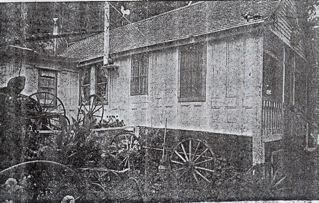When I first moved to Half Moon Bay from the Hillsdale area in the late sixties, there were a few locals that certainly stood out and it was always interesting to visit with them.
Bruce Haig seemed old to me but he was probably only about fifty. He had a weathered face like a farmer who had worked the land for many decades. Bruce was an ageless thinker, and he had more cool solutions to expensive problems than anyone Iâve ever known.
I met Bruce about 1969 as he rode his bike up to the front yard of âLittle Joeâ? Cotruvos house on the corner of Santiago and Francisco in El Granada. Bruce always rode a bike when he was off work, wherever he went to on the coast. He might be the only person in history who could smoke a pipe continually while riding up hill. His pipe had a large stainless stem between the tobacco bowl and the mouthpiece. He put toilet paper in it and this acted as the filter, “economic and efficient”, he exclaimed, owning about eight of the same design.
Bruce’s home had a window facing west that was about four- feet- high, and six-feet- wide with a fine view of the harbor. He could see Snakehead Point (also known as Pillar Point) and to the south the fog horn on the breakwater.
About 1975 new neighbors built a two-story house on the lot immediately to the west of Bruceâs 4 x 6 foot window blocking his entire coastal panorama. There was nothing but a wall of stucco looking back at Bruce. Bleak at best and the only thing breaking up the monotony of the wall was a very small sliding glass window and that was way up on the second floor.
Bruce went over, pipe in mouth, introduced himself to the new neighbors and asked in his always low-key voice, would they mind if he âpainted a mural on the blank wall of their home?” They said okay so Bruce drew what was missing from his ocean view on their stucco wall.
You could still see the “real view” from other windows in Bruce’s dining room. If you stood in the dining room you could compare the “real view” with the painted one on the stucco wall and then back again to the “real view”.
This same 4×6 window was broken in the top right corner, with about two feet missing from it. Most people would have replaced the window. Instead Bruce got out his salvaged pieces of stained glass, channeled lead, then made and installed a beautiful little stained glass sun with rays coming off it in this corner.
Bruce was the shop teacher at Hillcrest Reform School in San Mateo, and he had so many talents besides woodworking. A good sense of humor was one so the kids would obey him, I’m sure.
There were many dimensions to Bruce. He was an accomplished potter, had a kiln and a few potters’ wheels in the backyard. If he found a log in the woods or on the beach, he’d carve it; if he found some scrap metal he’d make a fancy wind vane out of it. But the result was never just average. Whatever Bruce Haig made was finished, thought out, and well done.
In the late sixties Bruce said he didn’t like the violence on t.v. so as his personal statement he took an old Phillips t.v., gutted it and covered the screen with fabric. That was the only channel you could watch!
If you met Bruce on the street you would never have dreamed he was as creative as he truly was, an inspiration to me for sure, and funny to boot!
Long live the Bruce Haigs of the world!!!
(Watercolor of Snakehead Point and the beach at El Granada by Galen Wolf).





